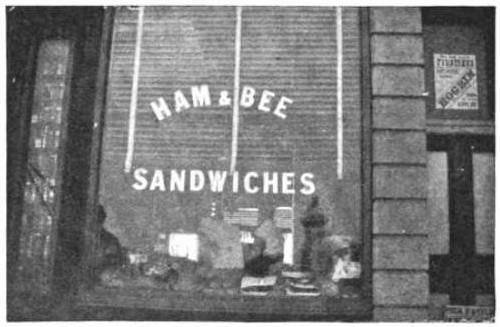
A shop in Herne Bay, Kent, advertised this specialty through the whole of the summer 1906 holiday season.
Reader John Day sent this photo to The Strand. “Herne Bay trippers are evidently careless of what they eat.”

A shop in Herne Bay, Kent, advertised this specialty through the whole of the summer 1906 holiday season.
Reader John Day sent this photo to The Strand. “Herne Bay trippers are evidently careless of what they eat.”

An engraving by Johann Martin Will, 1780.
Andrew Wyeth said, “I prefer winter and fall, when you feel the bone structure of the landscape. Something waits beneath it; the whole story doesn’t show.”
The vice president of a company went to the chairman of the board and said, ‘We are thinking of starting a new program. It will help us increase profits, but it will also harm the environment.’ The chairman of the board answered, ‘I don’t care at all about harming the environment. I just want to make as much profit as I can. Let’s start the new program.’ They started the new program. Sure enough, the environment was harmed.
Did the chairman harm the environment intentionally? In a 2003 study, 82 percent of respondents said yes, he did. But now consider this:
The vice president of a company went to the chairman of the board and said, ‘We are thinking of starting a new program. It will help us increase profits, and it will also help the environment.’ The chairman of the board answered, ‘I don’t care at all about helping the environment. I just want to make as much profit as I can. Let’s start the new program.’ They started the new program. Sure enough, the environment was helped.
Did the chairman help the environment intentionally? Only 23 percent of respondents said yes.
What should we make of this? Yale philosopher Joshua Knobe says, “It seems very puzzling that all we changed was this one word, just changing the word harm to help, and yet we’re now having completely different judgments about whether what he did was intentional or unintentional. Yet it seems like it’s only the moral status of what he did that is changing. … Somehow the moral judgments people are making are affecting their intuitions about something like how the mind works.”
An ancient graveyard of vast proportions has been found in Coffee county [Tenn.]. It is similar to those found in White county and other places in Middle Tennessee, but is vastly more extensive, and shows that the race of pigmies who once inhabited this country were very numerous. The same peculiarities of position observed in the White county graves are found in these. The writer of the letter says:– ‘Some considerable excitement and curiosity took place a few days since, near Hillsboro, Coffee county, on James Brown’s farm. A man was ploughing in a field which had been cultivated many years, and ploughed up a man’s skull and other bones. After making further examination they found that there were about six acres in the graveyard. They were buried in a sitting or standing position. The bones show that they were a dwarf tribe of people, about three feet high. It is estimated that there were about 75,000 to 100,000 buried there. This shows that this country was inhabited hundreds of years ago.’
— Woodbury [Tenn.] Press, quoted in The Journal of the Anthropological Institute, Feb. 8, 1876
A short distance below Coshocton [Ohio], on one of those elevated, gravelly alluvions, so common on the rivers of the West, has been recently discovered a very singular ancient burying ground. From some remains of wood, still apparent in the earth around the bones, the bodies seem all to have been deposited in coffins; and what is still more curious, is the fact that the bodies buried here were generally not more than from three to four and a half feet in length. They are very numerous, and must have been tenants of a considerable city, or their numbers could not have been so great. A large number of graves have been opened, the inmates of which are all of this pigmy race. No metallic articles or utensils have yet been found, to throw light on the period or the nation to which they belonged. Similar burying grounds have been found in Tennessee, and near St. Louis in Missouri.
— The American Journal of Science and Arts, January 1837
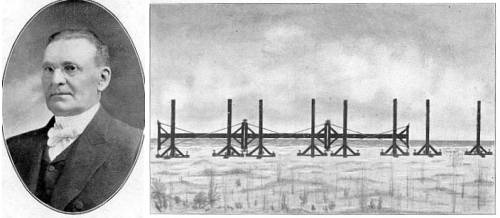
In 1897, Cyrus Teed proved that we inhabit a hollow earth. He did this by building a “Rectilineator,” essentially a giant straightedge that could extend a perfectly straight line across a great distance. On a convex earth this line should rise gradually in altitude as the earth’s surface falls away from it. But in his trials in Florida, Teed found that the line ran into the earth after 4 1/8 miles, proving that the surface is concave, in accord with his “Koreshan cosmogony.”
The extension of the arc of curvature which we have measured and have demonstrated to be concave, forms a circumference of about 25,000 miles; which conclusion, taken in connection with all the astronomical, geographical, and geodetic facts obtained by centuries of observation and survey, demonstrates that the surface of the earth upon which we live is the inner surface of a great cell about 8,000 miles in diameter.
“No one has ever seriously attempted either to debunk or to repeat the Rectilineator experiment,” writes John Michell in Eccentric Lives and Peculiar Notions, “but it is natural for those who can not bring themselves to accept its results to wonder how they were obtained. The Rectilineator apparatus, though cumbersome, was scientifically sound, and so was the principle behind its use, and one can hardly suppose that the Koreshan surveyors, who lived by the doctrines of their leader, were engaged in an elaborate conspiracy of deception. Perhaps the answer lies in the malleable, obliging nature of the universe, which reflects every image projected upon it and gives every experiment a tendency to gratify the experimenter.”
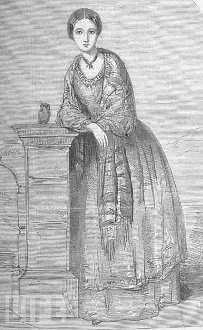
Florence Nightingale had a pet owl. She found it in 1850 on the Parthenon, where it had fallen out of its nest. She named it Athena and carried it away in her pocket, “where I regret to say he ate a live Athenian grasshopper, but failed to make any impression on two small tortoises which I was also bringing to England.”
At home, Athena became Nightingale’s “constant & sociable companion.” He slept in her pocket and nested in a bookcase, “where he made his presence known by uttering a peculiar cry, some 150 times, like a prayer.”
That cry would come to haunt her. The owl died during her preparations for the Crimea, but he visited her dreams as late as 1855, when she was in Constantinople: “Athena came along the cliff quite to my feet, rose upon her tiptoes, bowed several times, made her long melancholy cry, and fled away.”
“Poor little beastie,” she said. “It was odd how much I loved you.”
Mary Hamilton invented a new crime in 1746 — transvestite bigamy. Dressing as a man and calling herself Charles and George, she convinced no fewer than 14 women to marry her. At a trial in Somersetshire, the 14th wife testified against her “female husband”:
She swore that she was lawfully married to the prisoner, and that they bedded and lived together as man and wife for more than a quarter of a year; during all which time, so well did the impostor assume the character of man, she still actually believed she had married a fellow-creature of the right and proper sex.
The justices found Mary “an uncommon, notorious cheat” and sentenced her to six months in prison and three whippings. “And Mary, the monopoliser of her own sex, was imprisoned and whipped accordingly, in the severity of the winter of the year 1746.”
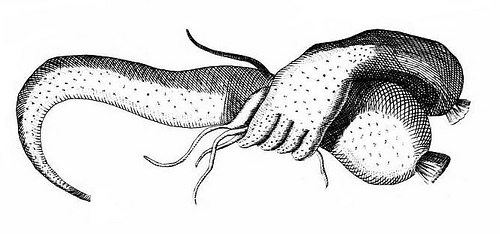
The parsnip of which a figure is annexed, represents a human hand, particularly the back of it so correctly, that it could not be surpassed by the best painter. This root was bought at the market of a woman who sold vegetables, and as it was shewn to several persons, it came at last into the hands of an engraver. Though roots of this kind, especially of the parsnip species, are not rare, yet there could scarcely be found one that so nearly resembles a human member. Dr. Menzel, however has seen a parsnip which accurately exhibits the figure of a man, complete in all its parts.
— Kirby’s Wonderful and Eccentric Museum, 1820
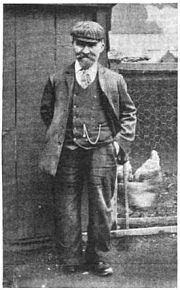
Events in the life of Welsh coal miner David Wilson, born 1846:
Seeing a pattern, he renounced for 28 years doing any work on Aug. 26, but in 1890 he forgot the date, went to work, and broke his left leg for the fourth time.
“The number of accidents the man has had is wonderful, but by far the most remarkable fact in connection with his history is their all happening on a certain day in the year,” wrote Walter Kruse in the Strand. “It is only explainable on the supposition that some natural law is at work, and that this law is in some way connected with the earth’s revolution around the sun, because the accidents always happened precisely when the earth reaches the same position in its orbit around the sun. It is very evident we have not arrived at the summit of our knowledge, and that there are causes and influences at work which are not noticed by the casual observer.”
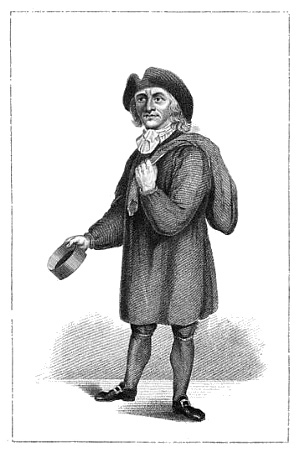
Thomas Britton (1644-1714) gave the 17th century proof that a flower can bloom wherever it’s planted. Though a humble coal merchant, Britton so distinguished himself in chemistry, book collecting, and music that he attracted admirers among the high-born. And, wonderfully, when he converted the tiny loft over his coal repository into a concert hall, they attended a weekly series of chamber music concerts there.
“The ceiling of the room in which his concert was held was so low that a tall man could scarcely stand erect in it,” runs one account. “The staircase was outside the house, and could scarcely be ascended without crawling; yet ladies of the first rank in the kingdom forgot the difficulty with which they ascended the steps in the pleasure of Britton’s concert, which was attended by the most distinguished professors.”
The concerts came to be thought the best in London, attracting both wealthy music lovers and the most eminent musicians (including, by some accounts, Handel himself).
Throughout all this Britton continued to work in the coal trade and charged only the lowest subscription rates. “Britton was indeed so much distinguished that when passing along the streets in his blue linen frock, and with his sack of small-coal on his back, he was frequently accosted with such expressions as these: ‘There goes the famous small-coal man who is a lover of learning, a performer of music, and a companion for gentlemen.'”
Indeed, after a lifetime mixing with high and low, Britton died renowned for both humility and cultivation. The poet John Hughes wrote, “Let useless pomp behold, and blush to find / So low a station, such a liberal mind.”